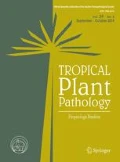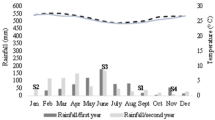Abstract
Rice is the third most important crop in Kenya after maize and wheat. Plant parasitic nematodes (PPN) are a major rice production constraint. The objective of this study was to determine the distribution and abundance of rice PPN in Kenya and their association with environmental variables. Soil and plant samples were collected from rainfed upland and irrigated lowland rice fields in Kirogo, Thiba, Nyangati, Ombeyi, Kombura, Kakola and Mwambe Sub-locations. Twenty-two PPN genera were identified across all Sub-locations with the highest (20) number of nematode genera recorded in rainfed upland rice fields. The nematode genera Scutellonema, Hoplolaimus, Ditylenchus, Hemicycliophora, Heterodera, Paralongidorus and Tylenchus were not recorded in the irrigated lowland rice fields while Criconemella and Tylenchorhynchus were not observed in rainfed upland fields. Canonical correspondence analysis of the relationship between soil properties and nematode abundance revealed a significant (P < 0.05) relationship between PPN abundance and potassium, sodium, sand and clay. The relationship between rainfall, minimum temperature and nematode genera was significant (P < 0.05) while maximum temperature was not significant (P = 0.928). Our results provide critical information for designing nematode management strategies in Kenyan rice fields.



Similar content being viewed by others
References
Allarangaye MD, Traoré O, Traoré EVS, Millogo RJ, Konaté G (2006) Evidence of non-transmission of rice yellow mottle virus through seeds of wild host species. Journal of Plant Pathology 88:309–315
Audebert A, Coyne DL, Dingkuhn M, Plowright R (2000) The influence of cyst nematodes (Heterodera sacchari) and drought on water relations and growth of upland rice in Cote d’Ivoire. Plant and Soil 220:235–242
Bakker W (1974) Characterisation and ecological aspects of rice yellow mottle virus in Kenya. Ph.D. Thesis. University of. Wageningen, The Netherlands
Bakonyi G, Nagy P, Kovacs-Lang E, Kovacs E, Barabas S, Repasi V, Seres A (2007) Soil nematode community structure as affected by temperature and moisture in a temperate semiarid shrubland. Applied Soil Ecology 37:31–40
Bridge J, SLJ P (1982) The rice root-knot nematode, Meloidogyne graminicola on deep water rice (Oryza sativa subsp. indica). Revue de Nematologie 5:225–232
Chinappen M, Lamberti A, Ciancio A, Jokhun P (1988) Losses caused by concomitant infestations of Criconemella onoensis and Helicotylenchus dihystera on upland rice in Mauritius. Nematologia Mediterranea 16:175–177
Coyne DL, Plowright R (2000) Pathogenicity of cyst nematode, Heterodera sacchari on rice in sand and clay soil. International Rice Research Notes 25:17–18
Coyne DL, Plowright R (2002) Assessment of the importance of individual plant-parasitic nematode species in a community dominated by Heterodera sacchari on upland rice in Cote d’Ivoire. Nematology 4:661–669
Coyne DL, Thio B, Plowright R, Hunt D (1999) Observations on the community dynamics of plant parasitic nematodes of rice in Cote d’Ivoire. Nematology 1:433–441
Coyne DL, Smith M, Plowright R (2001) Plant parasitic nematode populations on upland and hydromorphic rice in Cote d’ivoire: relationships with moisture availability and crop development on a valley slope. Agriculture, Ecosystems & Environment 84:31–43
Cuc N, Prot J (1992) Root-parasitic nematodes of deep -water rice in Mekong Delta of Vietnam. Fundamental and Applied Nematology 15:575–577
De Waele D, Elsen A (2007) Challenges in Tropical Plant Nematology. Annual Review of Phytopathology 45:457–485
Dutta NS, Prasad J (1990) Influence of Helicotylenchus multicinctus on the chlorophyll content, photosynthetic rate and root activity in rice. Nematologia Mediterranea 18:4–6
Evans AF, Perry RN (2009) Survival mechanisms. In: Perry RN, Moens M, Starr JL (eds) Root knot nematodes. CABI, Wallingford, pp 201–219
FAOSTAT, 2017. FAOSTAT [database on the internet]. Rome-Italy: Food and Agriculture Organization of the United Nations. Available from, http://faostat3.fao.org. Accessed 16 May 2017
Gilces CT, Santillán DN, Velasco LV (2016) Plant-parasitic nematodes associated with rice in Ecuador. Nematropica 46:45–53
Gitonga K (2016) Kenya corn, wheat and rice report. Available from, http://gain.fas.usda.gov. Accessed 18 May 2017
Hooper DJ (1990) Extraction and processing of plant and soil nematodes. In: Luc M, Sikora RA, Bridge J (eds) Plant parasitic nematodes in subtropical and tropical agriculture. CAB International, Wallingford, pp 45–68
Huang CS, Huang SP, Lin LH (1972) The effect of temperature on development and generation periods of Aphelenchoides Besseyi. Nematologica 18:432–438
Kable PF, Mai WF (1968) Influence of soil moisture on Pratylenchus penetrans. Nematologica 14:101–122
Kawashima K (1964) Damage by nematode and its control (Translation from Japanese). Nogyo Gijutsu 19:75–78
Kihoro J, Bosco NJ, Murage H, Ateka E, Makihara D (2013) Investigating the impact of rice blast disease on the livelihood of the local farmers in greater Mwea region of Kenya. Springerplus 2:1–13
Kinh DN (1981) Survival of Ditylenchus angustus in diseased stubble. International Rice Research. Newsletter 6:13
Lamberti F, Bleve-Zacheo T, TUopay DK, Ciancio A, Boiboi JB (1987) Relationships between Xiphinema ifacolum and rice in Liberia. Nematologia Mediterranea 15:303–314
Latif M, Haque A, Tajul M, Monsur M, Rafii M (2013) Interactions between the nematodes Ditylenchus angustus and Aphelenchoides besseyi on rice:population dynamics and grain yield reductions. Phytopathologia Mediterranea 52:490–500
Liao JL, Feng ZX, Li SM, Hu YM (2000) Species of Hirschmanniela on rice and their distribution in China. Nematologia Mediterranea 28:107–110
Mishra CC, Dash MC (1981) Distribution and population dynamics of nematodes in a rice field and pasture in India. Journal of Nematology 13:538–543
MOA (2008) Ministry of Agriculture, National rice development strategy (2008–2018). Available from, http://www.jica.go.jp. Accessed 20 May 2017
Neilson R, Boag B (1996) The predicted impact of possible climatic change on virus-vector nematodes in Great Britain. European Journal of Plant Pathology 102:193–199
Norton DC (1978) Ecology of plant-parasitic nematodes. Wiley-Interscience, New York
Nyang’au WO, Mati BM, Kalamwa K, Wanjogu RK, Kiplagat LK (2014) Estimating rice yield under changing weather conditions in Kenya using CERES rice model. International Journal of Agronomy 2014:1–12
Okada H, Niwa S, Takemoto S, Komatsuzaki M, Hiroki M (2011) How different or similar are nematode communities between a paddy and an upland rice fields across a flooding-drainage cycle? Soil Biology and Biochemstry 43:2142–2151
Onyango A (2014) Promotion of rice production: A likely step to making Kenya food secure. An assessment of current production and potential. Developing Country Studies 4:26–31
Pedramfar H, Pourjam E, Kheri A (2001) Plant parasitic nematodes associated with rice in Guilan Province, Iran. Iranian Journal of Plant Pathology 37:Pe285–Pe301
Peng S, Huang J, Sheehy JE, Laza RC, Visperas RM, Zhong X, Centeno GS, Khush GS, Cassman KG (2004) Rice yields decline with higher night temperature from global warming. Proceedings of the National Academy of Sciences 101:9971–9975
Pili N, Kyndt T, Gheysen G, Janssen T, Couvreur M, Bert W, Mibey R (2016) First report of Pratylenchus zeae on upland rice from Kwale County, Kenya. Plant Disease 100:1022
Plowright R, Bridge J (1990) Effect of Meloidogyne graminicola (Nematoda) on the establishment, growth and yield of rice CV Ir36. Nematologica 36:81–89
Pokharel RR (2009) Damage of root-knot nematode (Meloidogyne graminicola) to rice in fields with different soil types. Nematologia Mediterranea 37:203–217
Prasad J, Rao Y (1988) Effect of diferent inoculum levels of Pratylenchus indicus on the growth and yield of rice. Nematologia Mediterranea 16:123–124
Prot JC (1992) White tip. Pp 46-47 in Compendium of Rice Diseases, R. K. Webster and P.S. Gunnel (eds.) St. Paul: A.P.S. Press
Prot JC, Rahman ML (1994) Nematode ecology, economic importance, and management in rice ecosystems in South and Southeast Asia. In: Teng PS, Heong KL, Moody K (eds) Rice Pest Science and Management: Selected Papers from the International Rice Research Conference. Los Banos: International Rice Research Institute (IRRI), pp 129–144
Prot J, Savary S (1993) Interpreting upland rice yield and Pratylenchus zeae relationships: Correspondence analyses. Journal of Nematology 25:277–285
Pudasaini MPP, Viaene NV, Moens MM (2007) The influence of host and temperature on the vertical migration of Pratylenchus penetrans. Nematology 9:437–447
Pudasaini MPP, Viaene NV, Moens MM (2008) Hatching of the root-lesion nematode, Pratylenchus penetrans, under the influence of temperature and host. Nematology 10:47–54
R Development Core Team (2013) A Language and Environment for Statistical Computing. R Foundation for Statistical Computing Vienna, Austria
Rang ZW, Jagadish SVK, Zhou QM, Craufurd PQ, Heuer S (2010) Effect of high temperature and water stress on pollen germination and spikelet fertility in rice. Environmental and Experimental Botany 70:58–65
Sasser JN, Freckman DW (1987) A world prospective on nematology: the role of the society. In: Veech JA, Dickson DW (eds) Vistas on Nematology. Society of Nematologists, Hyattsville, pp 7–14
Soriano IRS, Prot J, Matias DM (2000) Expression of tolerance for Meloidogyne graminicola in rice cultivars as affected by soil type and flooding. Journal of Nematology 32:309–317
Stamps WT, Linit MJ (1998) Neutral storage lipid and exit behavior of Bursaphelenchus xylophilus fourth- stage dispersal juveniles from their beetle vectors. Journal of Nematology 30:255–261
Stirling G (1985) Observations on the biology and ecology of Paralongidor Usa Ustralis on rice in North Queensland. Nematologica 31:218–228
Sun M, Liu W, Lin M (2009) Effects of temperature, humidity and different rice growth stages on vertical migration of Aphelenchoides besseyi. Rice Science 16:301–306
Tzortzakakis EA, Trudgill DL (2005) A comparative study of the thermal time requirements for embryogenesis in Meloidogyne javanica and M. incognita. Nematology 7:313–315
Wiesel L, Daniell TJ, King D, Neilson R (2015) Determination of the optimal soil sample size to accurately characterise nematode communities in soil. Soil Biology & Biochemstry 80:89–91
Win PPW, Kyi PPK, Maung Z, Aung ZM, De Waele D (2013) Population dynamics of Meloidogyne graminicola and Hirschmanniella oryzae in a double rice-cropping sequence in the lowlands of Myanmar. Nematology 15:795–807
Yavuzaslanoglu EY, Elekcioglu HIE, Nicol JMN, Yorgancilar OY, Hodson DH, Yildirim AFY, Yorgancilar AY, Bolat NB (2012) Distribution, frequency and occurrence of cereal nematodes on the Central Anatolian Plateau in Turkey and their relationship with soil physicochemical properties. Nematology 14:839–854
Author information
Authors and Affiliations
Corresponding author
Additional information
Section Editor: Sarah J. Pethybridge
Rights and permissions
About this article
Cite this article
Namu, J., Karuri, H., Alakonya, A. et al. Distribution of parasitic nematodes in Kenyan rice fields and their relation to edaphic factors, rainfall and temperature. Trop. plant pathol. 43, 128–137 (2018). https://doi.org/10.1007/s40858-017-0194-9
Received:
Accepted:
Published:
Issue Date:
DOI: https://doi.org/10.1007/s40858-017-0194-9




